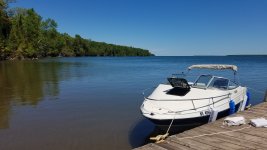Murph007
Cadet
- Joined
- May 12, 2011
- Messages
- 13
Motor died 20 miles out on Lake Superior when I brought it back to idle to anchor. Was not able to restart the motor except at full throttle but would die when trying to shift into gear. Got back to the house (Towboat US) and did a bunch of maintenance ( re-build the carbs, check the reeds, re-build the fuel pump, new filter, clean the spark plugs, etc) I finally got to the timing stage and I'm stumped to why the timing light will show the timing marks for a second or two then the marks will disappear. Light still flashing but no timing marks showing. Is this a symptom of something to do with the motor or possibly a bad timing light?




















